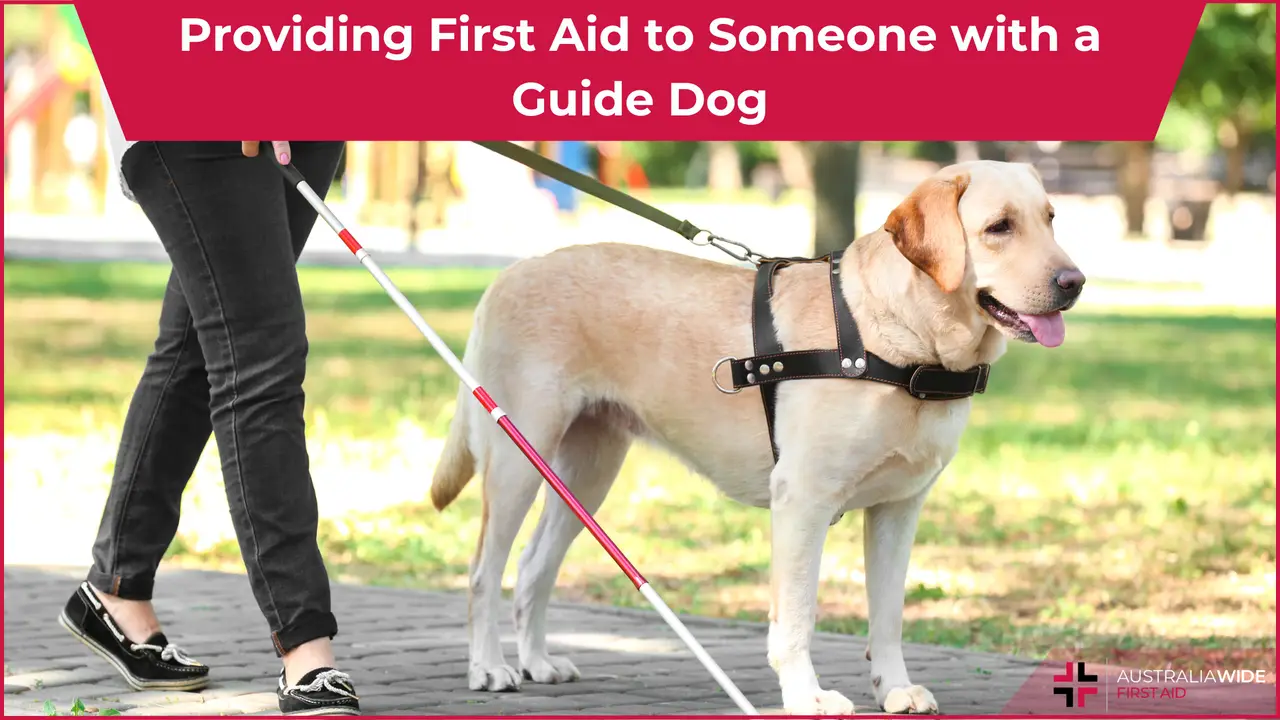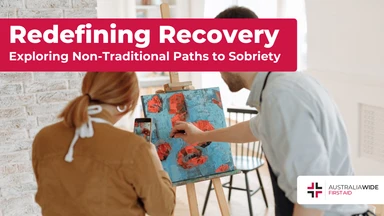Providing First Aid to Someone with a Guide Dog


Guide dogs are invaluable companions for individuals with visual impairments, disabilities and illnesses, providing them with independence and mobility.
If you find yourself in a situation where you need to provide first aid assistance to someone accompanied by a guide dog, it's essential to approach the situation with care and consideration for both the individual and their loyal canine companion.
A guide dog, or service dog, is a specially trained dog who works to help their handler live a more autonomous, mobile life.
A person may have a guide dog to assist with low or no vision, certain disabilities, and certain illnesses.
These dogs are chosen and trained from a very young age to be of assistance to their handler in a wide variety of circumstances. It is important to note, however, that the handler is always in charge, not the dog.
You can recognise a guide dog by their harness or vest – when wearing this, they are in work mode, and should be respected as such. Distractions, such as asking to pet or speak to them, can be dangerous for the dog and their handler.
Before providing any assistance, assess the situation to determine the nature and severity of the emergency. Remain calm and approach the individual with respect and sensitivity.
When approaching the person, it is best to do so on the opposite side to the dog. This shows respect and allows the dog to continue to do their work without distraction.
If the person with the guide dog is conscious and able to communicate, ask them how you can best assist. Respect their autonomy and listen carefully to their instructions.
Speak directly to the person, not their Guide Dog. The person will convey instructions to their dog as necessary, such as moving out of the way or staying in a particular spot.
Guide dogs are highly trained and play a crucial role in their owner's mobility. When providing assistance, be mindful of the dog's presence and avoid causing any unnecessary distress or interference.
Guide Dogs Australia provides this advice:
If the situation requires first aid intervention, provide clear and concise verbal instructions to the individual while considering their visual impairment.
Use descriptive language and offer reassurance throughout the process.
Prioritize the safety of both the individual and their guide dog.
If necessary, gently guide the dog away from any potential hazards or obstacles to prevent accidents.
If the individual needs to be moved to a safer location or requires transportation to a medical facility, offer your assistance while considering the presence of the guide dog. Allow the individual to hold onto their dog's harness while guiding them to safety.
Clear obstacles and spills out of the way, so that the Guide Dog can navigate the pathway safely.
While it's important to offer assistance, respect the individual's boundaries and preferences.
Some guide dog owners may prefer to handle their dog independently, while others may welcome assistance with gratitude.
Always ask for permission before offering physical assistance.
Remain calm and composed throughout the process, offering support and encouragement to the individual and their guide dog.
Your presence and assistance can provide reassurance during a potentially stressful situation.
If the individual requires medical attention beyond your capabilities, such as severe injuries or medical emergencies, seek professional help immediately. Call emergency services and provide relevant information about the situation.
Be aware that the Guide Dog is not permitted to go inside an ambulance, procedure wards, in-patient ward, or recovery area.
If the casualty is responsive, and needs to attend hospital, ask them what the best option is for their dog. This may include calling their family/friends/support to come and care for the dog, or dropping the dog off to a particular place.
If the casualty is not responsive, you can ask the paramedics or hospital staff the best course of action. You can also call Guide Dogs Australia for advice.
Never leave the dog behind unattended.
In conclusion, providing first aid assistance to someone accompanied by a guide dog requires compassion, communication, and awareness of their unique needs.
By approaching the situation with empathy and understanding, you can effectively support both the individual and their faithful guide dog during times of need.

March 25, 2025
Explore non-traditional paths to sobriety, including mindfulness, yoga, nutritional therapy, and community-based support, for a personalized approach to recovery.

September 7, 2022
Menopause is the final period, when a woman, trans man, or non-binary person assigned female at birth's ovaries run out of eggs and the body can no longer ovulate. Menopause comes with several symptoms, complications, and treatment options.

July 26, 2024
Transcutaneous Electrical Nerve Stimulation (TENS) is a therapeutic method of pain relief. It utilises an electrical device that emits electrical currents and streams the impulses via electrode patches attached to the skin.